Whether smoked in a peace pipe by
the Indians or in cigarettes by Hollywood stars, tobacco is intertwined with
the history of this continent. Even now, in the midst of the anti-smoking campaign,
it is no less a preoccupation: nowhere in the world are people so adamantly
and passionately against smoking. From a pure ritual of the Indians, smoking
was transformed into a commercial, addictive, cancerous industry. Hopefully
one day we will again discover the ritual...
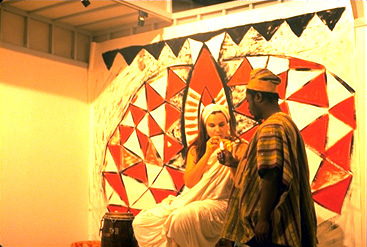 Several
years ago I had to pass through a cigar factory regularly on the way to my workspace.
Seeing the women making cigars made me curious about tobacco, smoke and fire.
I am not a smoker and yet, as if drawn by a magnet, I went further and further
into the symbolism of the cigar and tobacco leaf. With this unlikely subject
to consume me, I got in touch with a memory deep inside each one of us: when
the first spark produced the first flame. I went far from my background in Yugoslavia,
to a culture entirely different, in Africa, only to discover this same memory.
Several
years ago I had to pass through a cigar factory regularly on the way to my workspace.
Seeing the women making cigars made me curious about tobacco, smoke and fire.
I am not a smoker and yet, as if drawn by a magnet, I went further and further
into the symbolism of the cigar and tobacco leaf. With this unlikely subject
to consume me, I got in touch with a memory deep inside each one of us: when
the first spark produced the first flame. I went far from my background in Yugoslavia,
to a culture entirely different, in Africa, only to discover this same memory.
The spirit of lightning and fire
is everywhere, and as this natural force traveled, it was colored by the different
cultures it touched, given a variety of names and forms by the minds it inspired,
the hearts it penetrated: the energy with which the World began, with which
it will end, the energy of Fire, the Creator and the Destroyer.
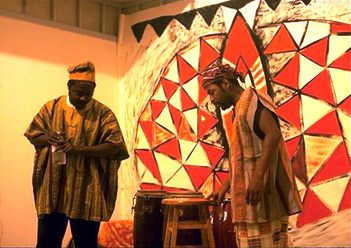 The
first memory I have of tobacco is from my childhood in Indonesia. I remember
rice fields, tea fields and tobacco fields. I remember men and women not only
smoking hand-rolled cigarettes, but chewing tobacco. Their teeth would rot from
it, and when they smiled, a bright Red stain flashed. Another strong memory
from this period surfaced many times as I delved into the tobacco smoking story
The
first memory I have of tobacco is from my childhood in Indonesia. I remember
rice fields, tea fields and tobacco fields. I remember men and women not only
smoking hand-rolled cigarettes, but chewing tobacco. Their teeth would rot from
it, and when they smiled, a bright Red stain flashed. Another strong memory
from this period surfaced many times as I delved into the tobacco smoking story
My parents took us to a funeral rite
in Bali. It was twilight. There were many dressed-up people, dancing and feasting;
it was a great celebration. When the funeral procession finally emerged, everyone
was so excited. A group of men came out carrying the corpse, which was wrapped
in a huge banana leaf and covered with lotus flowers. The structure upon which
the corpse was placed was built from bamboo sticks, and to me it seemed endless
in height. When they brought out his wife, the crowd went into a frenzy. She
was dressed in the finest embroidered silks, covered head to toe in jewels and
wore a gold crown on her head, with flowers all over. She climbed onto a tall
ladder and sat next to her late husband. At this point my memory blurs. They
proceeded to light the structure on fire. It became my nightmare. Someone said
that the bride goes to the heavenly abode with the husband. My father assured
me that this is not the case anymore; there is a law against it. I don't know
to this day what happened.
I had nightmares for years after.
Did she scream in the flame? Did she die with the man wrapped in the banana
leaf? Twenty years later, while traveling through India, I saw a TV show about
Sati, the practice of putting to death the bride of the dead man. Apparently,
to this day it goes on. In fact the subject of the show was a sixteen-year-old
bride who was put to death that year in a village. In Sati, a woman is drugged,
then a group of men come to the home and start dancing around her, chanting
a death song, and then they kill her. This is a way to ensure that the inheritance
stays in the husband's family and is not passed over to the wife. If somehow
the woman manages to escape this dreadful fate, she is doomed in the community
and may end up killing herself in despair or turning to prostitution to survive.
One of the images from this show that stuck in my mind was a rally of villagers
protesting the law which forbade the custom of bride burning. Behind the main
speaker was a picture of a beautiful woman enveloped in flames. The audience
was composed of angry chanting men. It sends a shiver through my spine.
Raised in an atheistic environment,
I've never been taught a religion. This made me free to enter temples, churches,
mosques and synagogues and marvel at the spiritual source in much the same way.
The theatrical quality of religious rituals moves me. I especially feel close
to the ancient nature religions, particularly Zoroastrianism, because there
the element of fire is central to worship. In Zoroastrianism, fire is believed
to be the son of God and is called on as a Warrior. The most sacred of fires,
the Bahram fire, is required in order to do battle with the spiritual demons
of darkness.
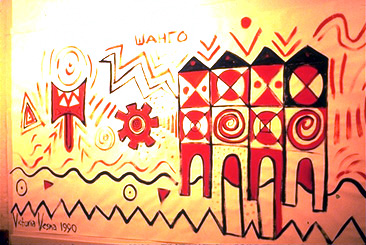 Millennia
of millennia ago, my ancestors migrated from the Himalayas. This warrior tribe
walked for miles, making rest stops of a few days, then continuing on to look
for their new home. They needed a sign in order to settle down. The sacred fire
was carried in golden pots and was never allowed to die out. Not only was it
a source of spiritual strength, warmth and light, it was also a protection against
wild beasts at night. When they reached the river Danube, they were very impressed
and decided to rest awhile on this fertile soil. That very night a bolt of lightning
struck at the center of the river and a two-headed bird came out with a loud
thunderclap. At its stomach was a Red and blue spiral which revolved with great
speed and emanated tremendous heat. Then the bird turned into a puff of smoke
and disappeared. Since the tribe worshiped Perun, the God of Thunder, they knew
that this was the auspicious sign they were looking for, and made this land
their home. Somewhere in my genetic makeup, the memory of this story is encoded.
Millennia
of millennia ago, my ancestors migrated from the Himalayas. This warrior tribe
walked for miles, making rest stops of a few days, then continuing on to look
for their new home. They needed a sign in order to settle down. The sacred fire
was carried in golden pots and was never allowed to die out. Not only was it
a source of spiritual strength, warmth and light, it was also a protection against
wild beasts at night. When they reached the river Danube, they were very impressed
and decided to rest awhile on this fertile soil. That very night a bolt of lightning
struck at the center of the river and a two-headed bird came out with a loud
thunderclap. At its stomach was a Red and blue spiral which revolved with great
speed and emanated tremendous heat. Then the bird turned into a puff of smoke
and disappeared. Since the tribe worshiped Perun, the God of Thunder, they knew
that this was the auspicious sign they were looking for, and made this land
their home. Somewhere in my genetic makeup, the memory of this story is encoded.
As a child
I spent many hours playing in the swimming pool, going up and down the metal
slide. Once while I was playing alone in the pool, it started raining, but in
Indonesia, tropical rains are usually ignored. They vanish as suddenly as they
appear. Flashes of lightning were sparking through the twilight sky. I lay on
my back in the water, floating, and was looking up in astonishment. This peaceful
moment was cut short by my father, who ran out shouting sternly that I must
immediately get out. I was puzzled by his behavior, and he screamed furiously
that I could have been electrocuted! This was a shocking idea to me. Images
of the lightning hitting my body kept going through my head. I kept trying to
imagine how it would feel, lightning hitting me.
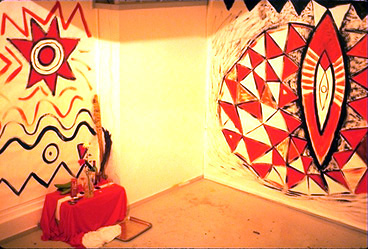 It
was a hot, quiet summer, 1985. Our family had gathered at the familiar spot,
the house in Motovon, Yugoslavia. Motovun is a magical 13th century Venetian
town on top of a hill twenty minutes away from the sea, which makes for a great
distance from the hustle and bustle of the tourist-crazed coast. The river Mirna,
which used to bring ships from the sea to this merchant town, has all but evaporated,
and Daytona, as it was called by the Italians, is blissfully removed from the
world.
It
was a hot, quiet summer, 1985. Our family had gathered at the familiar spot,
the house in Motovon, Yugoslavia. Motovun is a magical 13th century Venetian
town on top of a hill twenty minutes away from the sea, which makes for a great
distance from the hustle and bustle of the tourist-crazed coast. The river Mirna,
which used to bring ships from the sea to this merchant town, has all but evaporated,
and Daytona, as it was called by the Italians, is blissfully removed from the
world.
On either side of the entrance to
the house are two rooms with stone walls which were obviously stores; we heard
that the merchant in this house sold olive oil and flour. These rooms are cold
and were never really used, although they were the subjects of many of our daydreams.
Our mother had so many visions for these rooms that I lost track-her favorite
was of an antique store. But none of them materialized; the rooms are empty
to this day.
I was reading about Agni, the Indian
fire god-the Sun and the Heart of the Sun. Agni is the god who, as fire, receives
the sacrifice and, as priest, offers it to the gods. The element of fire also
pervades the whole universe. The Sun, in the highest heaven, is kindled in the
storm cloud and comes down to earth as lightning where he is ever reborn by
the hands of men. And so we are transformed through fusion with the light, the
Divine light.
Inspired by these images I decided
to do a performance called "Red Angel" and announced to everybody in town that
the show would last for five hours. First I started working on the space. I
painted the walls. One side was dark, with snakes moving toward the ceiling;
it was black, Red and brown. The other wall facing the dark side was light,
the future, and the center had a two-faced bird, looking both east and west;
next to it was a large spiral. Then I took some wooden panels and painted them
silver, with some Hebrew writing that I copied from a record that I borrowed
from Lucia, a friend who comes to Motovun every summer. She sparked off the
whole event in a way. We had one of those Motovun discussions about art, and
I set off to prove something, I don't quite remember what...
I was hanging out with a young guy
during my stay that summer. We were being really wild, like two stones hitting
each other, creating friction. He became part of this Event. I painted an old
chair and wrote "Red Angel" on it, put it in front of the door, as a sign. Then
I filled three stone vessels that had been used a long time ago for olive oil,
with colored water, one Red, another yellow, and the third black. Strange things
were being reflected here-Hebrew writing and a German flag? I don't know what
I was tapping into here; eerie echoes of World War 11?1 painted my whole body
Red. I then wrapped myself in a Red piece of fabric and put on my head a Montenegran
cap I found among our souvenirs in the house. The boy was in charge of the record;
it was to play continuously. The record was of songs of children in a Jewish
ghetto, in Yiddish. I really don't know why it moved me so. We lit many candles
around the room. I struck a pose of a Roman goddess statue and we opened the
doors to the public.
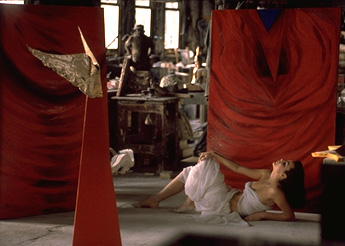 The
first hour was the hardest. I had many thoughts going through my mind, many
distractions from the people who started streaming in.But the worst was controlling
my body. After not too long, my muscles started tensing. I started thinking
that I wouldn't make it through. My mother came in and started panicking that
I was standing on a cold floor bare foot—there go the ovaries! My father was
getting drunk on local Red wine. It was all a challenge to keep from bursting
into laughter. People were talking into my ear, purposely trying to make me
move. And then I suddenly thought: "I'm wearing Red, like the monks, the Buddhist
monks; they meditate for hours without moving. So I will become one of them."
My eyes were half closed, and I moved my sight to a candle flame. Slowly the
sounds of the people surrounding me became a murmur. I visualized Motovun on
top of the hill, and myself the statue standing on top. The warm wind was caressing
my body, my Red garment flowing beautifully. In the distance I imagined how
the river moved when it was in its prime, with Venetian ships calmly flowing.
I looked up at the sun and felt the warmth like a bath of blissful energy. Then
suddenly I felt angels surrounding me, playing with me, touching me with their
Wings. Amorphous, they had no faces, like birds of energy, smiling energy. I
realized that they were communicating to me, that they approved of my action.
Slowly there were more and more of them, creating a spiral around my body and
up, up into the sky towards the center of the Sun. As I descended back into
the space, I heard blurred sounds first; then they became voices and I heard
someone whispering in my ear, "I love you," dropping something into my hands,
which were open and cupped. I closed my hand and slowly opened my eyes. There
was quite a sight in front of me; a pagan get-together had taken place. There
were food leftovers, opened bottles of wine with empty cups. People sat at the
edge of the room comfortably chatting. I had really become like a statue, non-imposing.
It was time to close the doors....
The
first hour was the hardest. I had many thoughts going through my mind, many
distractions from the people who started streaming in.But the worst was controlling
my body. After not too long, my muscles started tensing. I started thinking
that I wouldn't make it through. My mother came in and started panicking that
I was standing on a cold floor bare foot—there go the ovaries! My father was
getting drunk on local Red wine. It was all a challenge to keep from bursting
into laughter. People were talking into my ear, purposely trying to make me
move. And then I suddenly thought: "I'm wearing Red, like the monks, the Buddhist
monks; they meditate for hours without moving. So I will become one of them."
My eyes were half closed, and I moved my sight to a candle flame. Slowly the
sounds of the people surrounding me became a murmur. I visualized Motovun on
top of the hill, and myself the statue standing on top. The warm wind was caressing
my body, my Red garment flowing beautifully. In the distance I imagined how
the river moved when it was in its prime, with Venetian ships calmly flowing.
I looked up at the sun and felt the warmth like a bath of blissful energy. Then
suddenly I felt angels surrounding me, playing with me, touching me with their
Wings. Amorphous, they had no faces, like birds of energy, smiling energy. I
realized that they were communicating to me, that they approved of my action.
Slowly there were more and more of them, creating a spiral around my body and
up, up into the sky towards the center of the Sun. As I descended back into
the space, I heard blurred sounds first; then they became voices and I heard
someone whispering in my ear, "I love you," dropping something into my hands,
which were open and cupped. I closed my hand and slowly opened my eyes. There
was quite a sight in front of me; a pagan get-together had taken place. There
were food leftovers, opened bottles of wine with empty cups. People sat at the
edge of the room comfortably chatting. I had really become like a statue, non-imposing.
It was time to close the doors....
Later, I was told what had transpired.
Tourists passed through and took photographs, posing next to me. Lucia came
in and started crying; it really touched a soft spot in her. I guess I proved
whatever I set out to, which now completely escapes me. And then a group of
friends brought food and wine and sat down to enjoy the show. In my hand was
a rosary, with a Virgin Mary.
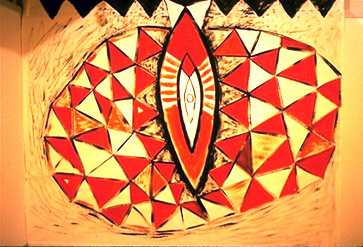 I
continued to work with the image of Red Angel in many media. Appropriately enough,
by strange circumstance I ended up having a workspace in a bronze foundry in
Corona, Queens. I was working on a Red Angel installation that traveled to Venice.
The presence of fire was constant.
I
continued to work with the image of Red Angel in many media. Appropriately enough,
by strange circumstance I ended up having a workspace in a bronze foundry in
Corona, Queens. I was working on a Red Angel installation that traveled to Venice.
The presence of fire was constant.
Every time bronze was melted, the
workers knew to call me to watch. Liquid metal being poured; I was witnessing
an ancient alchemical process. One moment hard, the next liquid. One moment
shapeless, the next a face, a body, anything out of our imagination. I made
one bronze during my short stay there, a Wing. Just before it was ready to be
cast, a fire broke out in the workroom. Thanks to one of the workers, it was
saved. It was in wax form at that point, and it would have just melted away.
The installation consisted of one
Red sculpture, with the wing; one white sculpture, a ship, egg shaped, on top
of which were found pieces of a shipwreck; and three paintings, two Red and
one white; the white one I named "White Result."
I was in a fiery creative mood there,
but just as soon as the pieces were completed, I lost the space; it was sold.
So once again I was without a workspace and I continued my artwork in a basement
on St. Marks Place belonging to Lawson, a friend and carpenter I've known for
years. It was fine at first, especially since Lawson is such a good craftsman.
He helped me build a Column, a Moon, the Ship and the pedestal for the Wing.
During this period I spent most of the time wearing a gas mask. We used very
toxic materials and in a way they mirrored the surroundings that were developing.
Crack crept into this space, and the situation deteriorated swiftly. Crack keeps
nasty company; pretty soon it became unbearable. This particular smoking ritual
is one of death, destruction and suicide; some very evil spirits are summoned
with its smoke.
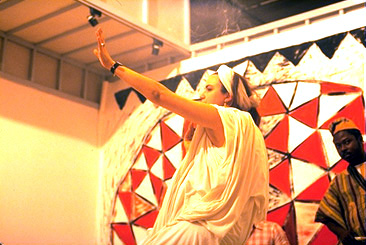 The
ancient Greeks reamed much from the Zoroastrian magi, who left no monuments
because they believed in natural powers. Herodotus commented: "The erection
of statues, temples and altars is not an accepted practice among them, and anyone
who does such a thing is considered a fool, because, presumably, the Persian
religion is not anthropomorphic like the Greek. God in their system is the whole
circle of the heavens and they sacrifice to him from the top of the mountains.
They also worship the sun, moon, earth, fire, water, and winds, which are their
only original deities...." Herodotus also mentions the Medean magi, who were
known long before the days of Zoroaster as a magico-priestly caste, one of the
six tribes of Medes. It is from this race of men that the word magic is
derived. To the Greeks, the word rnagia originally signified the religion,
reaming and occult of the Eastern magi. The magi penetrated into Greece, India
and even into China. They transcended religious differences, for there was always
something universal and international about the nature of magic. It was the
descendants of this priestly caste that came from the East to proclaim and worship
the newborn Christ.
The
ancient Greeks reamed much from the Zoroastrian magi, who left no monuments
because they believed in natural powers. Herodotus commented: "The erection
of statues, temples and altars is not an accepted practice among them, and anyone
who does such a thing is considered a fool, because, presumably, the Persian
religion is not anthropomorphic like the Greek. God in their system is the whole
circle of the heavens and they sacrifice to him from the top of the mountains.
They also worship the sun, moon, earth, fire, water, and winds, which are their
only original deities...." Herodotus also mentions the Medean magi, who were
known long before the days of Zoroaster as a magico-priestly caste, one of the
six tribes of Medes. It is from this race of men that the word magic is
derived. To the Greeks, the word rnagia originally signified the religion,
reaming and occult of the Eastern magi. The magi penetrated into Greece, India
and even into China. They transcended religious differences, for there was always
something universal and international about the nature of magic. It was the
descendants of this priestly caste that came from the East to proclaim and worship
the newborn Christ.
The Greeks had a goddess who represented
the priceless life-giving necessity of fire—Hestia. She was the deity of the
hearth, daughter of Cronus and Rhea. In Greek tradition she has almost no mythology;
she is mentioned only in the Homeric hymn to Aphrodite. She refuses both her
brother Poseidon (Water) and her nephew Apollo as consorts, insisting on remaining
a virgin. Hestia is a sacred principle personified and much honored. She kept
apart from the disputes on Mount Olympus, and was represented in the city, which
maintained the public hearth, as well as in the home. She was invoked before
all sacrifices, and colonizers from Greece took fire to their new lands from
their native city hearth, the prytaneia. The Romans continued the practice,
renaming the state goddess of the hearth Vesta.
The Zoroastrian bible was called Avesta; there is a direct connection, a tradition
handed down.
Vesta was also worshipped in every
household. The sacred fire of the state burned in Vesta's temple on Via Sacra,
just below the Forum; it was renewed on March 1st, the first day of the Roman
year (Angelica's birthday). Otherwise it burned perpetually. Her festival Vestalia
was held on June 9th, the day I was born. On that day her beast, the ass, was
given a holiday from labor and decorated with garlands of violets and strings
of small loaves. The storehouse of the temple of Vesta was opened from the 7th
to the 15th of June to enable the Roman matrons to bring their offerings to
the goddess. During this period all public business ceased.
The temple of Vesta in Rome represented
the house and hearth of the ancient kings, and just as the Rex sacorum was a
priest who represented the king, the vestal virgins represented the king's daughters.
They were originally four in number, later six, but always highborn girls from
patrician families. They had a number of duties but were principally the guardians
of the fire of the state hearth in the temple of Vestal. The office was a very
ancient one, older than Rome itself. The vestals were sworn to absolute chastity,
but they could return to private life after thirty years of service. If, during
that time, one was found guilty of breaking her vow, she was buried alive in
an underground chamber near the Colline gate, conveyed there bound hand and
foot in a covered litter. She was made to descend a long wooden stair, which
was then drawn up. (Michael Stapleton, Dictionary of Greek and Roman
Mythology, Peter Bedrick Books, New York, 1986, p. 207, Vestal )
Men who are connoisseurs of smoking
(in the Western world) always relate to their smoking passionately, as if to
a lover. ].M. Barrie's book Lady Nicotine about the pleasures of smoking
says that a gentleman must always use a "Vesta" to light his cigar. They differ
from ordinary matches only in the name, the tradition.
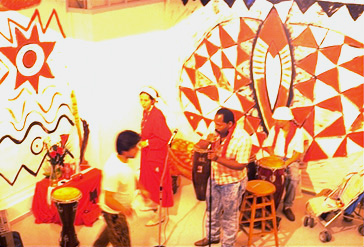 I
don't remember exactly where we were going, but we were in a bus when Shuli,
an artist friend also looking for workspace, told me about this one place I
might consider. A basement, again, but it happened to be in the middle of Soho.
Soho! I never even knew Soho when it belonged to the artists; that was before
my time. The only Soho I knew was of galleries, of trendiness, the very commercial,
very expensive Soho. Shuli also mentioned something about having to pass though
a very strange space. The strange space fumed out to be a cigar factory! It
looked like something out of the 19th century, the exploitation of the workers
in the most miserable circumstances. And that worker was a woman; in fact, only
women worked in this factory. At the entrance one of the workers was beating
the tobacco leaves with great anger in her movements.
I
don't remember exactly where we were going, but we were in a bus when Shuli,
an artist friend also looking for workspace, told me about this one place I
might consider. A basement, again, but it happened to be in the middle of Soho.
Soho! I never even knew Soho when it belonged to the artists; that was before
my time. The only Soho I knew was of galleries, of trendiness, the very commercial,
very expensive Soho. Shuli also mentioned something about having to pass though
a very strange space. The strange space fumed out to be a cigar factory! It
looked like something out of the 19th century, the exploitation of the workers
in the most miserable circumstances. And that worker was a woman; in fact, only
women worked in this factory. At the entrance one of the workers was beating
the tobacco leaves with great anger in her movements.
Daily I passed through, observing
these women, Hispanic women, illegal for sure, smoking as they worked! It was
quite a sight, and the smell—your eyes would water after only a few moments.
There is no way to describe that smell; it is so strong, it hurts.
I was drawn to this factory, to the
women. It was becoming an obsession. I wanted to do something with it, but I
had no idea what. A documentary? Definitely not. But I had to start somewhere,
so I decided to simply videotape the scene. I became familiar with the workers
and the owner of the factory, and when I asked him if it was okay he didn't
seem to mind. So I booked a day for camera and crew.
Two days before the shoot, I
was taken to dinner at 21—the famous 21, where the very famous and very rich
meet. Being the obsessive person that I am, throughout the dinner I discussed
only the cigar factory, how amazing it was to see those women smoking and rolling
tobacco. The image one usually has in mind is of a man smoking a cigar, a fat
boss ordering people around... not women, never women. Why is it o.k. for a
man to suck on a phallic symbol in public?
On our way out we stopped at the
restaurant's cigar stand. All this talk about cigars made my date want to light
one up. And there was this beautiful Latin girl, Emilia Cleopas, the cigar sales
girl. We started talking, and she spoke with such knowledge and passion about
cigars, I immediately invited her to the video shoot for an interview.
When we arrived at the factory for
the shoot, everything seemed fine. We set up the camera and lights and started
to videotape. The next moment there was a rising tension in the air; we began
to feel uncomfortable. The women started protesting, hiding their faces. Finally,
the factory owner came out and said: "Victoria, I'm sorry. Next thing you know,
they'll ask for a raise in pay and all kinds of bullshit."
I felt like an aggressor; the camera
had become like a gun being pointed at them, the lights as if for interrogation.
They were clearly frightened; frightened and angry. Angry because somebody had
told them that across the street there is a man who makes a lot of money with
video—Nam June Paik. They felt I was manipulating them, and I felt that they
were manipulated enough, so we retreated to the basement. We waited for the
cigar sales girl from 21.
When Emilia finally showed up, she
was all geared up to start her talk. I had only one request, to paint her lips
Red. She sat down and calmly gave a startlingly beautiful monologue about her
experience of the cigar. She opened up a whole now dimension about this most
male symbol in Western society—the phallic symbol itself. At 21, where she worked,
successful, rich men met and made deals. She felt that when they smoked the
cigar, they were practicing magic. Were they aware of that? Back in her neighborhood,
the people who smoke cigars are very religious people, and more often than not,
women. She smoked a cigar while she talked. It was very sensual the way she
sucked on it—slowly, like a good lover, taking her time.
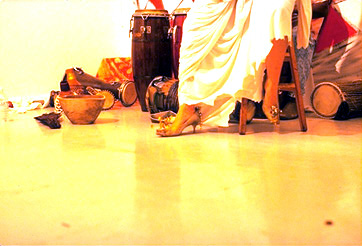 Emilia
personified the modern age Carmen to me, especially in this setting. In the
cigar factory she looked as if she belonged, and as if she came from another
planet. She said that Santeristas would puff cigar smoke into a bowl of water
and see your past, your future. Tobacco smoke is a very powerful medium.
Emilia
personified the modern age Carmen to me, especially in this setting. In the
cigar factory she looked as if she belonged, and as if she came from another
planet. She said that Santeristas would puff cigar smoke into a bowl of water
and see your past, your future. Tobacco smoke is a very powerful medium.
According to Emilia, loving to smoke
a cigar has nothing to do with penis envy. Women in South America smoke cigars,
and not much is thought of that. This is their way of reclaiming the power,
through the magic powers of smoke. At 21, men smoke a cigar after a multi-million
dollar deal, but she smoked to come closer to God. She said that there are two
Gods, the spiritual and the material—the Eastern and the Western. How she views
these men at 21 is particularly interesting. They smoke a cigar while they are
making a business deal because it allows them to see through the person they
are negotiating with. Is it possible that modern businessmen are tapping into
the archaic magic practices?
Bizet's Carmen worked in a cigar
factory. The thought of all those women together in the tropical heat, half-dressed,
rolling the cigars on their thighs must have inspired the opera. The smoke,
she sings, is elusive, like love, you cannot hang onto it.... Women are almost
always the workers in the factories; we are reminded that they are the creators
of the phallus.
Emilia thinks that men are intimidated
by women who smoke cigars. We are all so unaccustomed to this sensual sight.
I asked her to tell more about the religious aspect of smoking. Every Monday
morning when she woke up she smoked a cigar, to start her week.
And the ritual went like this: "I
light all my candles, and at the end of my prayer, I light the cigar. Instead
of inhaling it, I put it in my mouth and I blow out; that's the way you communicate
with the saints, 'cause the saliva is on it and all your thoughts are on it,
too. When I'm in deep thought, I smoke a cigar. When you die, your body leaves
in a puff of smoke. I guess it's like smoking a cigar." The Buddha come pared
rebirth to the lighting of a new candle from the flame of a dying one. The flame
goes on, but the candle or the body is consumed. In the "Voice of Silence,"
a Tibetan Buddhist text, it is said: "Out of the furnace of man's life and its
black smoke, winged flames arise, flames purified, that weave in the end the
fabric glorified of the... vestures of the Path." The cigar is never put out,
but the glowing spark is left to die. Emilia continued: "The cigar is very sacred
in Santerismo. It is the only way really to talk to the saints. Anything you
want to ask them, you ask through the cigar. All the women smoke cigars, all
the disciples. Santerismo is the oldest religion on earth. It comes from Africa.
Smoking a cigar is pure; it is a sign of power."
I had no knowledge of Santeria and
asked her to elaborate. I understood her saying that its roots were in Africa,
in Uruba. She didn't know the spelling or much else about it. But she was certain
that it was the oldest religion on earth. "Anytime I want to know anything abut
a person and their life, I smoke a cigar, and I'm able to see through them like
glass. Maybe that's why when I walked in here [the factory] all the women smiled
at me. I guess they knew deep down who I was."
Who was she? She came as an answer
to the undefined question I had about the women in the factory, the feelings
I got. She opened the door I was looking at; not the history of cigars, or the
different names and makes. I wasn't interested in the accepted facts; I wanted
the woman's point of view, the deeper truth, the ritual.
Right after this I was invited to
do a performance at a gallery in Soho. A few friends and I smoked cigars, including
Emilia, whose video was projected in the background on a large screen. The images
and the smoke offended the owners and we were kicked out.
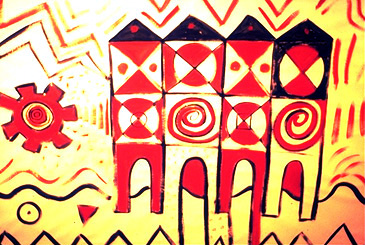 My
then future husband Bogdan and I went to California to conduct an interview
with his colleague, Murray Gell-Mann, a Nobel laureate and the discoverer of
quarks. I asked him if he knew where Urubas were and he corrected me: Yoruba,
in Nigeria. In fact, his interview began with him pointing to a Yoruba divination
bowl, which he jokingly said physicists need in order to make discovcries.
My
then future husband Bogdan and I went to California to conduct an interview
with his colleague, Murray Gell-Mann, a Nobel laureate and the discoverer of
quarks. I asked him if he knew where Urubas were and he corrected me: Yoruba,
in Nigeria. In fact, his interview began with him pointing to a Yoruba divination
bowl, which he jokingly said physicists need in order to make discovcries.
The Yoruba culture was quite advanced
when the white man started taking them captive in the 17th century to be their
slaves, they were organized in a series of kingdoms and had a complex social
structure. THe most important kingdom was Benin. Their most important city to
this day is lle-lfe, which according to their legend was created by Orisha Obatala
and is the origin of all that exists. From this powerful culture, they left
behind a rich legacy of art. Almost every piece of African art that I found
exe traordinary came from Nigeria, from the Yoruba tribe. The most fascinating
part of their culture is the mythological aspect, the religious beliefs and
practices. But that I found out later, definitely not from the books in the
library. The material I found there was dry, studious and lacking in explanations
of the rituals and magic.
In the beginning of the 17th century,
the Ewe tribes invaded Yorubaland, forcing the Yorubas to migrate to the Nigerian
coast, where many of them were captured by slave traders and brought to the
New World. Their white masters
felt threatened by their strange worship of deities, and forbade them to practice
their religion. They were forced to accept Catholicism, and accept they did.
Except that instead of the Catholic religion absorbing the African, it happened
the other way around. The African religion was much stronger, because it is
rooted in Mother Earth, in Nature. So the slaves outsmarted their white masters
by hiding their Orishas behind the ""front" of Catholic saints. They appropriated
with time many customs from their new home, but their roots were never lost.
And just as the religion would become less African, a new boat of slaves would
come in and refresh their memory.
There are also theories about the
connection of the Yoruba to Egypt. Some Egyptians migrated to Nigeria looking
for fertile land next to water. They taught the natives there their religion
and showed them how to craft sculptures and pottery. Over time Yoruba evolved
to the form it has now, reaching its peak in the thirteenth century.
There are some 4,000 Orishas (deities)
in the Yoruba pantheon; it resembles the complex pantheon of the Egyptian Gods.
In their human portrayal we are reminded of the Greek Gods. It is all connected--after
all, Africa and Mediterranean Europe aren't that far away. Western historians
arrogantly assume that Africans didn't mix much with the Classical cultures,
and appropriate the glories of Egypt's past as if a completely different race
were in question.
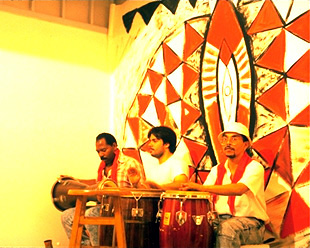 While
immersed in images of Africa, with a map of the continent above my kitchen table,
I got an editing job for a woman who was working on an educational video about
AIDS in Africa. After this session, a dancer booked time with me in another
editing room. When we walked in, the room was still occupied. At the monitors
was a girl dressed all in white, and on the screens was... Africa. She excused
herself for running overtime. I asked where the footage was from. "Nigeria,"
she said. Nigeria! Then I asked her if she knew anything about the Yorubas.
She responded: "These are Yoruban rituals that I videotaped." We started talking,
much to the dismay of the dancer waiting for me, but this was what I was searching
for. I told her about Emilia. She asked if she was a priestess. I had no idea;
the thought had never occurred to me. I asked her to write down her telephone
number and next to the number she wrote "Basha Alpern, Yoruba priestess."
While
immersed in images of Africa, with a map of the continent above my kitchen table,
I got an editing job for a woman who was working on an educational video about
AIDS in Africa. After this session, a dancer booked time with me in another
editing room. When we walked in, the room was still occupied. At the monitors
was a girl dressed all in white, and on the screens was... Africa. She excused
herself for running overtime. I asked where the footage was from. "Nigeria,"
she said. Nigeria! Then I asked her if she knew anything about the Yorubas.
She responded: "These are Yoruban rituals that I videotaped." We started talking,
much to the dismay of the dancer waiting for me, but this was what I was searching
for. I told her about Emilia. She asked if she was a priestess. I had no idea;
the thought had never occurred to me. I asked her to write down her telephone
number and next to the number she wrote "Basha Alpern, Yoruba priestess."
It wasn't easy getting a hold of
Basha. I tried calling many times; she lived in a hotel uptown on Broadway.
I was never sure if she got the messages. Finally one day I got a booking for
editing and it fumed out to be with her. She required titles over her Nigerian
footage. So I learned in the process the names of different dances, rituals,
cities.... Basha lived part time in Nigeria and worked for the king(! ), videotaping
his family and social affairs. Occasionally she herself would appear in the
video, and it was guise a sight. A white woman (of Jewish background) dressed
all in white, in the middle of Africa, a Yoruba priestess. I wondered how she
got there. Through the drum, she said. She played the conga drum, started following
the history of the drum. "When you follow the history of the drum, you find
the history of the people."
The tape I was helping her with turned
out robe for a panel discussion she was organizing, on the Yoruba culture. When
she asked me to videotape the event, I knew that I was coming closer to the
real story. The guests were Baba Afolabi Epega, a Nigerian babalawo (high priest
of Yoruba), Adeyemi Bob Thomson, an African-American practitioner, and
Beatrice Morales Cozier, an anthropologist
from Cuba. Throughout the discussion, Bob Thomson thoughtfully smoked a cigar.
Earlier I had approached him and asked about the connection, but he quickly
dismissed me. ("You silly girl.")
I started asking myself how all this
connected with the cigar factory, with those women. I was wondering if I was
losing sight. Towards the end my frustration grew apparent and there ensued
a long dialogue between the panelists and myself at the camera. My first question
referred to the book I was reading connecting the Yorubas to Egypt. The response
was that it was the other way around; that Egypt assimilated the Yoruba culture;
that lle-lfe is the beginning of mankind. I dared to ask what the importance
of women in the rituals is and also about the fact that in Nigeria polygamy
is commonplace. This seemed to really create some disturbance in the room. The
babalawo was especially perturbed. He asked me if I knew where my husband was,
trying to point out that when a man has more women they know exactly who he's
with. I was unhappy with the direction all this was taking and finally directed
a question to Beatrice Morales about women and cigars. Bob Thomson made a joke:
"Please help her; she's been asking this question all day." I knew she was the
one who could help me out of this impasse. And she was. She didn't act as if
it were a far-fetched question, didn't avoid the subject, but proceeded to talk
about women in the 16th and 17th centuries who were merchants of tobacco. She
had to cut the answer short because it was going away from the subject that
they had met there for, but in Beatrice I knew I had found the right person
and was determined to continue our discussion. Immediately after the panel meeting
I asked her for an interview. It wasn't easy, since the people running the place
were anxious to get us out. So I climbed out onto the terrace with the camera
person and set up lights. We shot a ten minute interview, until they kicked
us out of there, too. It didn't look like I was going to be able to continue
at another time because she lived in New Orleans and was very busy finishing
her dissertation in Cuban anthropology. Here are a few things she said at our
first encounter:
One of the things that's
important in the history of tobacco is the role of women. The period you
were probably looking at is the 19th century; the period I am talking about
is the 16th century. So imagine the conditions. There were very few European
women in the Caribbean. It was composed of people working for the crown,
the settlers who came without women and made it with the African women,
the Congolese and the Indians over there, the Tainos we call them. The Tamos
blended in and disappeared as a race, but their culture did not die. They
passed on their culture to the next group of people who came to work there,
the Africans.
And the tricky part is to
understand how these women managed to run their businesses under such a
tremendous condition of domination. It also might give us a different picture
of how sexuality was used. These women were not married women, and they
were classified during Christian times as prostitutes. They had various
lovers—the story of women and their many husbands. That's part of the hidden
story. So we only get an idea of these women looking at the mythology of
female divinities and their lifestyle. That puzzled me. I asked why is it
that Oshun is so independent and all of the Orishas have these qualities
and they are being classified as prostitutes? But they were being judged
from a very Christian perception of things which gives women very little
flexibility. It puzzled me that women were selling tobacco not only in Cuba
but also in the Dominican Republic, which had a big tobacco industry. They
were networkers.
At that point we were rudely interrupted
by the person in charge and ordered to stop and get out. I begged for only five
minutes more and he agreed "Five minutes!" "Thank you," I said and turned to
Beatrice to go on.
What you just did is exactly what
I am talking about. Subordination. The way you just appealed to get your objective,
to reach you goal. These women were marked in literature as prostitutes, thieves,
women of the world. But I think, between us, and I don't know how open I want
to be about this, that they were the backbone of religion. Because I think
that the Ifa priest came very late, to bring this superiority, patriarchy,
which is what is claimed to have maintained the religion. And tobacco gave
them an ability to buy their freedom. The Spanish brought with them an institution
called Cortasion, which they borrowed from the Romans. The slaves were treated
like human beings, not like later in the 19th century. You were a human being,
a persona, and you could buy your freedom and also marry to freedom.
And the women were using this to the fullest extent!
This insight changes history
because of the fact that we don't see women as making decisions; we don't
see woman as actors in history. So when you begin to look at Cuban history
you see all these institutions that we see now and that we are so proud of,
that Africans were able to retain in the New World. If you were to find the
hidden character, the contribution, you would find that the women are right
there. And I think that's the lead to follow, to uncover. Just like when we
uncover the history of Afro-Cubans we have to pay attention to the role of
women and tobacco. Without concentrating solely on women, the tobacco allows
you to discover the hidden actor. I think that is something we can continue
to uncover as we do more work.
She concluded hastily as the man
once again appeared, this time determined to get us out.
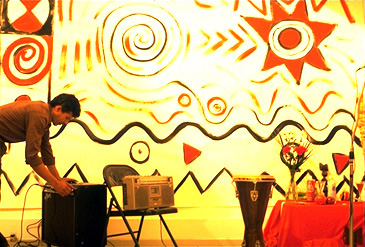 All
this reminded me of something that happened nine years ago. It was a very hot
and humid summer. I lived on Seventh Street between B and C. I went out to get
some groceries. At St. Marks Place I stopped and browsed around at what was
being sold on the street. Lots of junk, as usual, hot bicycles and other wares.
And there, in the middle of the chaos was sitting a young man, clean shaven,
dressed in black. In front of him on the pavement was a piece of blue velvet
on top of which were three or four religious pieces. I bought a silver cross
from him and left. On my way home I heard some Latin music and singing from
a small church. There was a man standing at the door. I wanted to take a peek.
He said: "Come in, come in." I stepped in. A young girl with a pretty face in
a white lace dress approached me. She said "I will translate to you; I will
be your Guide." She took me by the hand and sat me down, next to her. I was
enjoying the music, singing with percussion, congas and guitars. It was wonderful.
I turned to the girl and told her that it gave me shivers how beautiful it was.
She said that meant I was in the presence of God, then got up, went to the front
and whispered something in the priest's ear. Then the priest came to the microphone
and spoke. People started turning around and looking at me. His speech became
more and more passionate, he pointed at me. The priest said that he had a message
from God and that I was sent to them to be purified from Sin. He asked me to
step to the altar. I had no way out, so I proceeded. I came to the front, he
told me to lean down. A woman was on the other side of him. They laid their
hands on me and started screaming for the Devil to come out. Then they started
playing a rhythm on the drums and chanting I looked to the left, to the right;
people were turning in circles like dervishes, going into a frenzy. A woman
was crying. They poured water on the ground, on me. Then, slowly everyone settled
down. I gave the cross I had bought earlier to the girl, excused myself, took
my groceries and left. As I crossed the street to my door, put the key in, a
torrential flood of rain suddenly descended. This sent a chill through me; I
ran up all six flights of stairs in one breath. When I walked in my lower body
was covered with blood.
All
this reminded me of something that happened nine years ago. It was a very hot
and humid summer. I lived on Seventh Street between B and C. I went out to get
some groceries. At St. Marks Place I stopped and browsed around at what was
being sold on the street. Lots of junk, as usual, hot bicycles and other wares.
And there, in the middle of the chaos was sitting a young man, clean shaven,
dressed in black. In front of him on the pavement was a piece of blue velvet
on top of which were three or four religious pieces. I bought a silver cross
from him and left. On my way home I heard some Latin music and singing from
a small church. There was a man standing at the door. I wanted to take a peek.
He said: "Come in, come in." I stepped in. A young girl with a pretty face in
a white lace dress approached me. She said "I will translate to you; I will
be your Guide." She took me by the hand and sat me down, next to her. I was
enjoying the music, singing with percussion, congas and guitars. It was wonderful.
I turned to the girl and told her that it gave me shivers how beautiful it was.
She said that meant I was in the presence of God, then got up, went to the front
and whispered something in the priest's ear. Then the priest came to the microphone
and spoke. People started turning around and looking at me. His speech became
more and more passionate, he pointed at me. The priest said that he had a message
from God and that I was sent to them to be purified from Sin. He asked me to
step to the altar. I had no way out, so I proceeded. I came to the front, he
told me to lean down. A woman was on the other side of him. They laid their
hands on me and started screaming for the Devil to come out. Then they started
playing a rhythm on the drums and chanting I looked to the left, to the right;
people were turning in circles like dervishes, going into a frenzy. A woman
was crying. They poured water on the ground, on me. Then, slowly everyone settled
down. I gave the cross I had bought earlier to the girl, excused myself, took
my groceries and left. As I crossed the street to my door, put the key in, a
torrential flood of rain suddenly descended. This sent a chill through me; I
ran up all six flights of stairs in one breath. When I walked in my lower body
was covered with blood.
I never had an explanation of what
transpired that day. But now I was getting an inkling. Certainly it wasn't a
purely Christian affair. It was more like a shamanistic ritual. It must have
been a Santeria church that I walked into.
Santeria is not confined to the ignorant
and the uneducated. Some of the people I met who are followers of the cult are
real intellectuals. There are some 100 million practitioners of the cult in
Latin America and the U.S., and that is a conservative estimate. In Cuba, where
Santeria has developed extensively, the Yorubas are known as lucumi This
term is derived from the Yoruban word Akumi, which is the name given to a native
of Aku, a region of Nigeria where a lot of the Yorubas come from. The Cuban
lucumis were influenced by the Catholic imagery, although the essence of the
religion is purely African. I was delighted to have met Beatrice. She was from
Cuba and an anthropologist! At the panel meeting she said that her mother, Rosa
Levya "Shango Laramie," was a priestess, and many times wanted her to become
one too. She resisted, saying that she was interested in anthropology, to which
her mother responded that there is no difference, and that one day she would
have to face her destiny. It was her mother who initiated Basha into the Yoruba
religion.
The ceremony of initiation was renamed
asiento in Cuba, a Spanish word which means seat. The choice of this word may
be explained by the fact that the saints are believed to take possession of
their initiates and literally "mount" them. The santera is commonly known as
the "horse" of the saints. It is almost identical in the Voodoo religion. During
the initiation, the mind is conditioned for its future work. One is initiated
into the mysteries and rites of the particular Orishas who are recognized as
the "Mother" and the "Father."
When Castro came to power, many
Cubans fled the country, bringing with them the African rituals and magic. Soon
it spread throughout the South, particularly New Orleans and Miami, as well
as New York and New Jersey. Who would believe that the city that symbolizes
the height of civilization and modernity has so many practitioners of this cult!
But in New York you can see numerous botanical, which are the centers for practitioners.
These stores were opened by women originally, and they are where you can purchase
your candles and potions. And for a fee, it can be arranged for someone to cast
or rid a spell. Sometimes it is quite costly, all depending on the seriousness
of the situation at hand.
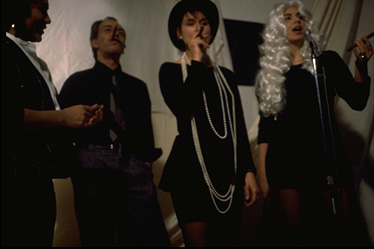 The
Havana cigar is considered by connoisseurs to be the creme de la creme. It has
been a forbidden fruit since 1959, when the U.S. put an embargo on Cuban tobacco.
And the symbol of the capitalist world, many times seen in Communist caricatures,
suddenly became readily available in the Soviet Union. And so Cuban magic traveled
to Russia. Meanwhile Castro recently received an award from the United
The
Havana cigar is considered by connoisseurs to be the creme de la creme. It has
been a forbidden fruit since 1959, when the U.S. put an embargo on Cuban tobacco.
And the symbol of the capitalist world, many times seen in Communist caricatures,
suddenly became readily available in the Soviet Union. And so Cuban magic traveled
to Russia. Meanwhile Castro recently received an award from the United
Nations for quitting the cigar! Many
Cubans believe that Castro owes his success to the black magic of the Cuhan
mayomberos (witches). It is rumored that the African deities placed him
in his position of power. In fact, quite a few dictatorships in Latin America
have been credited to works of magic. Only recently, when Noriega fled from
the U.S. troops, they found remnants of a magic ritual in his room. Animal parts
candles, offerings. And the New York Ames reported that he always wore
Red underwear as a means of protection.
Cuba has a peculiar history owing
largely to its geographical placement. Less than 90 miles from the Florida Keys,
it commands the entrance to the Gulf of Mexico and the Panama Canal. Now that
Noriega has been ousted and the Soviet Union has gone broke, it finds itself
isolated. The Indians who inhabited the island at the time of Columbus's landing
possessed no written language and because they were peaceful were annihilated
or absorbed, or else died out. At least three cultures swept through the island
before the arrival of the Spaniards: the Guanahatabeyes, the Ciboneyes, and
the Tainos, whom Beatrice mentioned earlier.
Most is known of the last group.
They had a rather advanced economic system based on agriculture. Tobacco, cotton
and corn were the most important part of the economy. The Tainos believed in
a supreme invisible being and their religion was idolatry. Ancestor worship
was common and they carved idols that resembled their ancestors. Tobacco was
used for smoking as well as for religious ceremonies and for curing the ill.
There was almost no mingling of races between the Spaniards and the Indians.
But the black slaves did have contact with the Indians. After all, their cultures
weren't that far apart from one another. They both worshipped nature, above
all, and their ancestors. Beatrice Morales spoke about this connection.
Emilia's Monday morning cigar-smoking
was a reenactment of an ancient Indian ritual. Beatrice translated a description
of the ritual from Spanish:
The rebel Indians communicated with
their ancestral warriors by keeping their bones in a clay pot and smoking tobacco;
this pleased the ancestors and ensured victory. One of the most interesting
rituals in the Afro-Cuban spiritual houses is the peculiar way in which the
mediums smoke tobacco. The Afro-Cuban medium, and all the spiritistas, place
the lit part of the cigar in their mouth, and they inhale the smoke in this
way, without breathing or opening the mouth. At the stream end of the cigar,
which is not lit, they exhale the smoke which reaches out into a fine, beautiful
line and leaves a trail of aroma in the air, covering the room. And thus they
sit in a circle. The tobacco ritual prepares the environment so that the group
can transcend their everyday world. The power of culture is amazing. In the
same way, we can see that tobacco was being smoked 500 years ago by the indigenous
people in the Caribbean. This ritual was passed on to the Afro-Cuban women who
were the traders of tobacco. Some people believe that tobacco is symbolic of
the AfroCuban culture. It's a combination of strength; and it's composed of
different cultures—the AfroSemitic culture, which goes back to the 13th and
14th centuries when the Moors, Africans, Jews, and Gypsies formed a minority
in Spain. We know that there was a lot of cultural assimilation going on when
they came to Cuba in the 15th and 16th centuries....
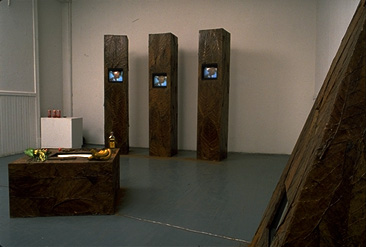 The
Yoruba tradition, as well as the Indian, was written down for the first time
when it came to Cuba. Familiar symbols began to emerge as I read about Shango.
Shango is a storm deity of the Yoruba. Each town or village in Nigeria has its
own Orisha who acts as a patron saint and protector of the people. Shango is
worshipped in the city of Oyo. This divinity was once a king, a strong ruler
and a great doctor. But he was also tyrannical. He could kill people by breathing
fire from his mouth.
The
Yoruba tradition, as well as the Indian, was written down for the first time
when it came to Cuba. Familiar symbols began to emerge as I read about Shango.
Shango is a storm deity of the Yoruba. Each town or village in Nigeria has its
own Orisha who acts as a patron saint and protector of the people. Shango is
worshipped in the city of Oyo. This divinity was once a king, a strong ruler
and a great doctor. But he was also tyrannical. He could kill people by breathing
fire from his mouth.
There are different versions of the
story of how Shango fled to the forest and eventually hanged himself. But all
agree that the place of this tragic event was Koso. This shameful event was
mocked by his enemies and they cast scorn on his name. So his friends contacted
a great magician who summoned a series of thunderstorms, causing the devastation
of the city of Oyo. His followers immediately proclaimed that the storms were
caused by Shango's anger. Many sacrifices were made in his honor and his followers
to this day proclaim "oba ko so," meaning ""the king did not hang himself."
In New Oyo, the central shrine is
the palace of the king Alafin, who is said to be a direct descendant of Shango.
His symbols are his mortar, in which he prepares the thunderbolts; his magic
spell; his castle; and a double-edged axe, which is usually made of wood, painted
in Red and white and covered with cowrie shells. His colors are Red and white
and his numbers are four and six. He is the patron of the firemen. He is invoked
in works of dominion, passion and many other endeavors.
All of the legends and the central
theme of Shango are based on power, be it procreative, de-. structive, medicinal
or moral. The power is materialized in Shango's staff, which generally depicts
a woman with a double-edged axe on her head. Thunderbolts are called thunder
axes and are said to fall on the ground whenever there is a storm. Many double-edged
axes are found in the Mediterranean world also. The Yoruba compare the noise
of thunder to the bellowing of the ram, and these animals are sacred to Shango
and wander freely about the marketplaces. He is propitiated with apples, bananas,
roosters, cigars, and on special occasions with the ram himself. At the mention
of his name, his followers lift themselves off their seats in a show of respect
for the electrifying Orisha.
The shrines of Shango in Oyo have
a collection of thunderstones which preserve the power. These are collected
by his priests from houses that are hit by lightning. The thunderstones are
kept inside a wooden bowl which sits on a tall mortar (pilon) know as
odo Shango. On the Orisha's festival the odo is washed in water containing the
crushed leaves of several plants, the juice of a snail and palm oil. Then a
rooster is sacrificed and the blood poured over the thunderstones. Later the
blood of the ram is poured over the stones. These African practices have been
preserved nearly intact in Santeria.
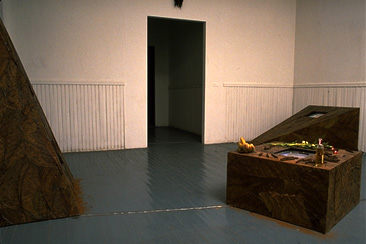 Saint
Barbara is Shango's syncretization. She was identified with Shango because she
has a cup in one hand (Shango's mortar), a sword (his axe) in the other, and
a castle at her feet. Her mantle is Red, her tunic white, and she is associated
traditionally with thunder and lightning. She is also the patroness of artillerymen.
Once again, a virgin and a martyr. Her legend dates back to the 7th century.
She was the daughter of Dioscorus, who kept her beauty guarded. When she professed
Christianity to her father, a pagan, he was so enraged that her ordered her
to be tortured and beheaded. Dioscorus himself performed the execution, and
on his way home was struck by lightning and reduced to ashes. She is venerated
as one of the 14 Auxiliary Saints, the Holy Helpers, and is invoked in thunderstorms.
Saint
Barbara is Shango's syncretization. She was identified with Shango because she
has a cup in one hand (Shango's mortar), a sword (his axe) in the other, and
a castle at her feet. Her mantle is Red, her tunic white, and she is associated
traditionally with thunder and lightning. She is also the patroness of artillerymen.
Once again, a virgin and a martyr. Her legend dates back to the 7th century.
She was the daughter of Dioscorus, who kept her beauty guarded. When she professed
Christianity to her father, a pagan, he was so enraged that her ordered her
to be tortured and beheaded. Dioscorus himself performed the execution, and
on his way home was struck by lightning and reduced to ashes. She is venerated
as one of the 14 Auxiliary Saints, the Holy Helpers, and is invoked in thunderstorms.
The Santeria cult, like Voodoo, is
frightening to a lot of people because it deals with our primitive, archetypal
feelings, something that many of us have lost touch with. But any religion,
cult, or philosophy can be equally dangerous, depending on how we empower it
with our thoughts.
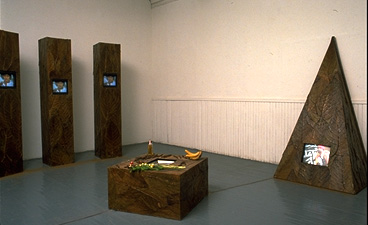 Every
day I went down to the basement and worked with tobacco leaves and wood. I was
working on an installation at P.S. 1, which was to open on January 9th, my grandmother's
birthday. It consisted of six large objects, covered with tobacco leaves, with
videos inside, interviews with three women: Emilia, the artist, Basha, the priestess,
and Beatrice, the anthropologist. Through their stories I would present a completely
different viewpoint of the cigar and tobacco, the woman's point of view.
Every
day I went down to the basement and worked with tobacco leaves and wood. I was
working on an installation at P.S. 1, which was to open on January 9th, my grandmother's
birthday. It consisted of six large objects, covered with tobacco leaves, with
videos inside, interviews with three women: Emilia, the artist, Basha, the priestess,
and Beatrice, the anthropologist. Through their stories I would present a completely
different viewpoint of the cigar and tobacco, the woman's point of view.
But December was approaching and
I hadn't succeeded in setting up an interview with Basha or Beatrice. It was
as if they were avoiding me. They probably didn't know what to make of my interest
in the subject; generally there is a strong suspicion of outsiders of the religion.
The Yoruba religion is composed of an intricate system of rituals and ceremonies
which are usually performed in the forest; it is a nature religion. There was
a great deal of persecution from the white masters, so the slaves were forced
to surround their religion in a cloak of secrecy. This secrecy, which never
existed in Nigeria, still exists today, and I was experiencing it.
I met with Basha to discuss the possibility
of an interview and she told me that there were a lot of racial tensions and
she was afraid she might aggravate the situation. When the Cubans came to America
with their religions, many Afro-Americans rediscovered their religious heritage,
a religion of their own, not imposed by the white man. And here was a white,
Jewish woman, a priestess of Yoruba! And not to mention that she worked for
the king of Nigeria on top of it all. When Basha realized that I was pregnant,
she opened up to me, and told me that she had been I wanted a child desperately
and had been trying for awhile. Beatrice Morales, on the other hand, lived in
New Orleans, and was very busy with her dissertation, besides having three small
children to take care of. But she told me that she might find some time when
visiting New York. So there was a remote chance.... I was in the last trimester
and my stomach was bulging. One time in the subway, while reading about Santeria
I came across this: December 4th millions of followers honor Shango
and Santa Bar bare. Suddenly everything fell into place. Shango, Cigars and
Women. I had less than a week! I ran to the first phone and called Basha, asking
if we could arrange the interview on Shango Day in the cigar factory. For the
first time she showed some enthusiasm, saying that she had thought about it
and decided to do it, but that she would talk about the sacred drums and introduce
herself as a musician. My excitement grew when she told me that Beatrice was
coming to town the following day, and that she probably would like the idea
of doing the interview on Shango Day. After all, her mother was a priestess
of Shango. December 4th was a Sunday, which was the only day of the week that
the factory was empty all day. Basha decided to organize a small celebration
and got her group together, Grupo Ore-lre. Before they all arrived she called
and asked if I could bring Red and white flowers, some candy, a cup of coffee,
green bananas, and rum. I obliged. They brought their drums, talked about the
bata drum—the sacred drum—and made a libation. Beatrice Morales came a little
later and gave a beautiful talk about Shango, women and cigars. I felt that
the goddess of thunder had smiled.
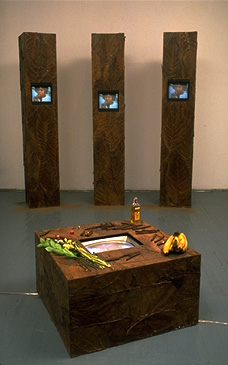 I
was walking barefoot on a dusty road somewhere in India, for days and days.
Exhausted, I arrived at an ancient temple at the steps of which was a monk.
I approached him, asking for directions; he didn't respond. A young girl came
up to me and said that he was in deep meditation and in another reality, he
couldn't hear me. I decided to go in and drink some water. As I passed the monk,
he opened his eyes and pointed at me: "She, she is the sacrifice." Terrified,
I started to run away, through the temple, into the garden. There was suddenly
a group of them behind me, chasing me like an animal. I ran desperately, approached
a small ruin of a house, ran through it, out the back door, again to a garden.
There I saw high stone steps, covered with moss. The stairway to heaven. I started
the long, long climb. There seemed to be no end. I was surrounded by beautiful
tropical greenery. I climbed and climbed, gasping for breath. When I reached
the top, on the last stair was the Woman. She was so ancient, transparent, dressed
in white. Her eyes were open, but she seemed to look right through me. I pleaded
with her: "They are right behind me, please help me, they want to sacrifice
me." She didn't respond, didn't move. I was desperate, how do I reach her, which
language does she speak. A lightning flash went off and I understood that not
words but only thought could save me.... I woke up in panic. Sacrifice, sacrifice.
The contact between us and God is enforced with sacrifice. This is how we receive
power. All ancient people have sacrificed first humans, then animals, finally
food. Now we reach a point of self-sacrifice. But 1, myself, must make that
decision; no one is allowed to put me to the stake.
I
was walking barefoot on a dusty road somewhere in India, for days and days.
Exhausted, I arrived at an ancient temple at the steps of which was a monk.
I approached him, asking for directions; he didn't respond. A young girl came
up to me and said that he was in deep meditation and in another reality, he
couldn't hear me. I decided to go in and drink some water. As I passed the monk,
he opened his eyes and pointed at me: "She, she is the sacrifice." Terrified,
I started to run away, through the temple, into the garden. There was suddenly
a group of them behind me, chasing me like an animal. I ran desperately, approached
a small ruin of a house, ran through it, out the back door, again to a garden.
There I saw high stone steps, covered with moss. The stairway to heaven. I started
the long, long climb. There seemed to be no end. I was surrounded by beautiful
tropical greenery. I climbed and climbed, gasping for breath. When I reached
the top, on the last stair was the Woman. She was so ancient, transparent, dressed
in white. Her eyes were open, but she seemed to look right through me. I pleaded
with her: "They are right behind me, please help me, they want to sacrifice
me." She didn't respond, didn't move. I was desperate, how do I reach her, which
language does she speak. A lightning flash went off and I understood that not
words but only thought could save me.... I woke up in panic. Sacrifice, sacrifice.
The contact between us and God is enforced with sacrifice. This is how we receive
power. All ancient people have sacrificed first humans, then animals, finally
food. Now we reach a point of self-sacrifice. But 1, myself, must make that
decision; no one is allowed to put me to the stake.
It seems that the most disturbing
fact to Western people about Yoruba and Santeria is the aspect of sacrificing
animals. And yet, if you think about it, we participate in a much more horrendous
mass sacrificial rite. Millions of domestic animals are kept in the most uncivilized
cages and slaughtered with no emotion. We do not see and therefore do not accept
the fact that we are part of this sacrificial rite. Much blood is spilled daily,
for our Big God—material wealth. I am not coming to the defense of the reality
of crime and violence that is connected to the Santeria cult; many drug dealers
are worshippers, and summon the protective powers of the African deities. However,
what is frightening and repelling to us Westerners is the simplicity, the bluntness.
I set up the tobacco installation
and shortly thereafter gave birth to Angelica. She was two weeks old when it
was taken down. It is as if this whole project had a note of fertility ringing
through it. Basha got pregnant, finally. She told me that the conception took
place right around the Shango Day celebration. And throughout this childbearing
year, the landlady of my studio was desperately trying to get pregnant. Forty
and single, she came across some terrible barriers. The time of her ovulation
was invariably a time of crisis in the studio. The frozen sperm was being Federal
Expressed from California, and it had to arrive just at the precise moment.
Once, my mother stayed at the loft for a while, and then my tall, dark and handsome
brother moved in. He had had a fight with his wife. My landlady ape preached
him, and said he could stay provided he donated some sperm. I don't know how
he responded, but after that incident I was handed papers from the lawyer to
terminate my lease, stating that this was a strictly commercial property. Everything
was straightened out eventually; my landlady adopted a beautiful baby girl after
all the struggle. It is as if the childbearing urge became contagious; everyone
around me was having babies all at once. I was passing out cigars like mad.
Angelica turned one and I traveled
to Cincinnati to do a performance. Upon my arrival at the hotel where I was
to stay, a large group of Yoruba drummers stood at the entrance. They too were
guests that day. I took this as a sign that I was not losing my way, and felt
sure of myself while performing that night in front of a handful of people.
I am neither an anthropologist nor
a priestess. Like Emilia I am in between these two worlds: the artist, the messenger.
With the cigar and lightning I made a journey, from the Golden Leaf cigar factory
in Soho to Nigeria, Cuba, Spain, Greece, Serbia and back. And I decided to create
my own myth in the end, the story of the beginning of the World. In the end,
I deliver my own story of the beginning.
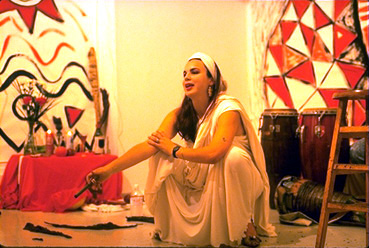 In
the beginning there was a Woman. She created the World first in her Mind, then
through her electrical body. Her favorite place for meditation and creation
was on top of mountains that today we call the Himalayas. Her skin was transparent.
milkywhite, all the veins could be seen clearly. She had blue blood flowing
through. Her World was still. As She, the goddess Earth, created the seas, lakes,
rivers and oceans, the mist entered her pores and she had a terrible urge to
push. Through her third eye, millions of pearls were released, each of which
fumed into a different creature as it touched the Earth or the Waters.
In
the beginning there was a Woman. She created the World first in her Mind, then
through her electrical body. Her favorite place for meditation and creation
was on top of mountains that today we call the Himalayas. Her skin was transparent.
milkywhite, all the veins could be seen clearly. She had blue blood flowing
through. Her World was still. As She, the goddess Earth, created the seas, lakes,
rivers and oceans, the mist entered her pores and she had a terrible urge to
push. Through her third eye, millions of pearls were released, each of which
fumed into a different creature as it touched the Earth or the Waters.
When She opened her eyes, She realized
that it was lonely on the top and she was missing a partner. She envisioned
Man. But to create Him, She needed Tobacco, the sacred plant with which Magic
is performed. She descended from her great heights and searched for the plant.
When She finally found it, She rolled it into a Big Cigar, in order to create
smoke. En route back, She placed the Cigar in her Vagina, so as not to lose
it. This gave her such pleasure as She climbed back up, that She envisioned
Man with an organ just that shape. Together they would create offspring, in
unity. When She took it out, She bled—Red blood. She squeezed some milk from
her breast onto the Cigar, lit it with a lightning stroke and puffed on it.
The smoke produced a thunderclap and a flash of lightning. She puffed on it
again, and an image of Man appeared out of the smoke. She called Him Thunder
and immediately fell madly in love with Him. Because Her love for Him was so
potent, She endowed Him with equal powers, the power of Good and Evil, and the
ability to create anything He wished. To further prove Her love, She decided
to take on the burden of carrying their offspring, to endure the pain of childbirth
and to feed through Her breast. Together, they created a whole Hierarchy of
Gods and Goddesses and the World's situation steadily became more and more complex.
Each deity had a Vision and Power different from the other. Woman and Man were
busy keeping equilibrium. It was a difficult task to keep the harmonious balance,
so they divided their duties and spent less and less time together. Every full
moon, the Woman spilled blood from her body to commemorate Her original sacrifice.
One time She felt particularly nervous and unappreciated by Man, neglected.
So She fumed herself into a Golden Bird and flew high into the heavens to bring
down some thunderbolts, to exhibit her Rage. On the way down, She dropped one,
and it fell right at the feet of her Man. It fumed into a most magnificent Red,
white and golden blaze. He was delighted, thinking that this was a gift from
the heavens, failing to notice Her. This enraged Her even more; the thunderbolts
fell creating a Super Loud Noise. All Creatures of their World scattered in
fear, an emotion that had never existed before. She threw the Tobacco on the
flame and created a double-edged axe, throwing it at His feet, then pissed on
the flame and put the fire out. But while doing this, some of her pubic hair
burned, and this smell spread all over the World, awakening sexual desire in
all Beings, Male for Female, Female for Male. She desired unity. But Her Man
got enraged while witnessing her display of power and didn't like being reminded
that She is his Creator. He grabbed the axe and threw it with all his might
to the Center of the Earth. This brought out the warrior spirit in all races,
and they started separating into tribes, striving to dominate one another. Men
and Women came together in sexual desire and love, creating offspring, but each
carried a memory of this Great Event and would keep separating and coming together.
To this day they haven't worked it out. And this is how it all began, with a
Bang.
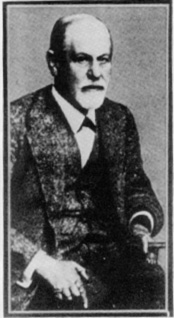 I
wonder how Freud would analyze that! Freud, the Father of psychoanalysis, who
needed cigars in order to work. He was fatally addicted, he who claimed that
addictions are substitutes for the "single great habit primal addiction"—masturbation.
He who wrote about women's "penis envy" was so obsessed with smoking cigars
that he developed a terrible cancer that caused him much suffering and pain.
He who wrote so much of the oral primitive needs failed at self-analysis and
epitomized the Western Man who has lost touch with Nature. It is true that Tobacco
causes cancer, but that is because the Ritual of worshipping Mother Nature has
been forgotten, and in our emptiness we seek endless gratification in overindulgence
of one sort or an' other. Freud and Jung had an exhaustive exchange about the
importance of smoking.
I
wonder how Freud would analyze that! Freud, the Father of psychoanalysis, who
needed cigars in order to work. He was fatally addicted, he who claimed that
addictions are substitutes for the "single great habit primal addiction"—masturbation.
He who wrote about women's "penis envy" was so obsessed with smoking cigars
that he developed a terrible cancer that caused him much suffering and pain.
He who wrote so much of the oral primitive needs failed at self-analysis and
epitomized the Western Man who has lost touch with Nature. It is true that Tobacco
causes cancer, but that is because the Ritual of worshipping Mother Nature has
been forgotten, and in our emptiness we seek endless gratification in overindulgence
of one sort or an' other. Freud and Jung had an exhaustive exchange about the
importance of smoking.
In the end Freud said, to get out
of it all: '"Sometimes a Cigar is Only a Cigar." Well, now I can relate to that!
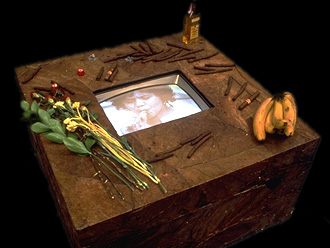 Beginnings
are always very difficult for me. Perhaps I was marked for this fate by way
I was born. My mother was in labor for two lays and two nights. To this day
she describes in vivid detail the horror of my birth. There was a knife next
to her bed; they had to wrestle it away from her. She wanted to kill herself....
Finally I came into the world, feet first.
Beginnings
are always very difficult for me. Perhaps I was marked for this fate by way
I was born. My mother was in labor for two lays and two nights. To this day
she describes in vivid detail the horror of my birth. There was a knife next
to her bed; they had to wrestle it away from her. She wanted to kill herself....
Finally I came into the world, feet first.
 Several
years ago I had to pass through a cigar factory regularly on the way to my workspace.
Seeing the women making cigars made me curious about tobacco, smoke and fire.
I am not a smoker and yet, as if drawn by a magnet, I went further and further
into the symbolism of the cigar and tobacco leaf. With this unlikely subject
to consume me, I got in touch with a memory deep inside each one of us: when
the first spark produced the first flame. I went far from my background in Yugoslavia,
to a culture entirely different, in Africa, only to discover this same memory.
Several
years ago I had to pass through a cigar factory regularly on the way to my workspace.
Seeing the women making cigars made me curious about tobacco, smoke and fire.
I am not a smoker and yet, as if drawn by a magnet, I went further and further
into the symbolism of the cigar and tobacco leaf. With this unlikely subject
to consume me, I got in touch with a memory deep inside each one of us: when
the first spark produced the first flame. I went far from my background in Yugoslavia,
to a culture entirely different, in Africa, only to discover this same memory. The
first memory I have of tobacco is from my childhood in Indonesia. I remember
rice fields, tea fields and tobacco fields. I remember men and women not only
smoking hand-rolled cigarettes, but chewing tobacco. Their teeth would rot from
it, and when they smiled, a bright Red stain flashed. Another strong memory
from this period surfaced many times as I delved into the tobacco smoking story
The
first memory I have of tobacco is from my childhood in Indonesia. I remember
rice fields, tea fields and tobacco fields. I remember men and women not only
smoking hand-rolled cigarettes, but chewing tobacco. Their teeth would rot from
it, and when they smiled, a bright Red stain flashed. Another strong memory
from this period surfaced many times as I delved into the tobacco smoking story Millennia
of millennia ago, my ancestors migrated from the Himalayas. This warrior tribe
walked for miles, making rest stops of a few days, then continuing on to look
for their new home. They needed a sign in order to settle down. The sacred fire
was carried in golden pots and was never allowed to die out. Not only was it
a source of spiritual strength, warmth and light, it was also a protection against
wild beasts at night. When they reached the river Danube, they were very impressed
and decided to rest awhile on this fertile soil. That very night a bolt of lightning
struck at the center of the river and a two-headed bird came out with a loud
thunderclap. At its stomach was a Red and blue spiral which revolved with great
speed and emanated tremendous heat. Then the bird turned into a puff of smoke
and disappeared. Since the tribe worshiped Perun, the God of Thunder, they knew
that this was the auspicious sign they were looking for, and made this land
their home. Somewhere in my genetic makeup, the memory of this story is encoded.
Millennia
of millennia ago, my ancestors migrated from the Himalayas. This warrior tribe
walked for miles, making rest stops of a few days, then continuing on to look
for their new home. They needed a sign in order to settle down. The sacred fire
was carried in golden pots and was never allowed to die out. Not only was it
a source of spiritual strength, warmth and light, it was also a protection against
wild beasts at night. When they reached the river Danube, they were very impressed
and decided to rest awhile on this fertile soil. That very night a bolt of lightning
struck at the center of the river and a two-headed bird came out with a loud
thunderclap. At its stomach was a Red and blue spiral which revolved with great
speed and emanated tremendous heat. Then the bird turned into a puff of smoke
and disappeared. Since the tribe worshiped Perun, the God of Thunder, they knew
that this was the auspicious sign they were looking for, and made this land
their home. Somewhere in my genetic makeup, the memory of this story is encoded. It
was a hot, quiet summer, 1985. Our family had gathered at the familiar spot,
the house in Motovon, Yugoslavia. Motovun is a magical 13th century Venetian
town on top of a hill twenty minutes away from the sea, which makes for a great
distance from the hustle and bustle of the tourist-crazed coast. The river Mirna,
which used to bring ships from the sea to this merchant town, has all but evaporated,
and Daytona, as it was called by the Italians, is blissfully removed from the
world.
It
was a hot, quiet summer, 1985. Our family had gathered at the familiar spot,
the house in Motovon, Yugoslavia. Motovun is a magical 13th century Venetian
town on top of a hill twenty minutes away from the sea, which makes for a great
distance from the hustle and bustle of the tourist-crazed coast. The river Mirna,
which used to bring ships from the sea to this merchant town, has all but evaporated,
and Daytona, as it was called by the Italians, is blissfully removed from the
world. The
first hour was the hardest. I had many thoughts going through my mind, many
distractions from the people who started streaming in.But the worst was controlling
my body. After not too long, my muscles started tensing. I started thinking
that I wouldn't make it through. My mother came in and started panicking that
I was standing on a cold floor bare foot—there go the ovaries! My father was
getting drunk on local Red wine. It was all a challenge to keep from bursting
into laughter. People were talking into my ear, purposely trying to make me
move. And then I suddenly thought: "I'm wearing Red, like the monks, the Buddhist
monks; they meditate for hours without moving. So I will become one of them."
My eyes were half closed, and I moved my sight to a candle flame. Slowly the
sounds of the people surrounding me became a murmur. I visualized Motovun on
top of the hill, and myself the statue standing on top. The warm wind was caressing
my body, my Red garment flowing beautifully. In the distance I imagined how
the river moved when it was in its prime, with Venetian ships calmly flowing.
I looked up at the sun and felt the warmth like a bath of blissful energy. Then
suddenly I felt angels surrounding me, playing with me, touching me with their
Wings. Amorphous, they had no faces, like birds of energy, smiling energy. I
realized that they were communicating to me, that they approved of my action.
Slowly there were more and more of them, creating a spiral around my body and
up, up into the sky towards the center of the Sun. As I descended back into
the space, I heard blurred sounds first; then they became voices and I heard
someone whispering in my ear, "I love you," dropping something into my hands,
which were open and cupped. I closed my hand and slowly opened my eyes. There
was quite a sight in front of me; a pagan get-together had taken place. There
were food leftovers, opened bottles of wine with empty cups. People sat at the
edge of the room comfortably chatting. I had really become like a statue, non-imposing.
It was time to close the doors....
The
first hour was the hardest. I had many thoughts going through my mind, many
distractions from the people who started streaming in.But the worst was controlling
my body. After not too long, my muscles started tensing. I started thinking
that I wouldn't make it through. My mother came in and started panicking that
I was standing on a cold floor bare foot—there go the ovaries! My father was
getting drunk on local Red wine. It was all a challenge to keep from bursting
into laughter. People were talking into my ear, purposely trying to make me
move. And then I suddenly thought: "I'm wearing Red, like the monks, the Buddhist
monks; they meditate for hours without moving. So I will become one of them."
My eyes were half closed, and I moved my sight to a candle flame. Slowly the
sounds of the people surrounding me became a murmur. I visualized Motovun on
top of the hill, and myself the statue standing on top. The warm wind was caressing
my body, my Red garment flowing beautifully. In the distance I imagined how
the river moved when it was in its prime, with Venetian ships calmly flowing.
I looked up at the sun and felt the warmth like a bath of blissful energy. Then
suddenly I felt angels surrounding me, playing with me, touching me with their
Wings. Amorphous, they had no faces, like birds of energy, smiling energy. I
realized that they were communicating to me, that they approved of my action.
Slowly there were more and more of them, creating a spiral around my body and
up, up into the sky towards the center of the Sun. As I descended back into
the space, I heard blurred sounds first; then they became voices and I heard
someone whispering in my ear, "I love you," dropping something into my hands,
which were open and cupped. I closed my hand and slowly opened my eyes. There
was quite a sight in front of me; a pagan get-together had taken place. There
were food leftovers, opened bottles of wine with empty cups. People sat at the
edge of the room comfortably chatting. I had really become like a statue, non-imposing.
It was time to close the doors.... I
continued to work with the image of Red Angel in many media. Appropriately enough,
by strange circumstance I ended up having a workspace in a bronze foundry in
Corona, Queens. I was working on a Red Angel installation that traveled to Venice.
The presence of fire was constant.
I
continued to work with the image of Red Angel in many media. Appropriately enough,
by strange circumstance I ended up having a workspace in a bronze foundry in
Corona, Queens. I was working on a Red Angel installation that traveled to Venice.
The presence of fire was constant. The
ancient Greeks reamed much from the Zoroastrian magi, who left no monuments
because they believed in natural powers. Herodotus commented: "The erection
of statues, temples and altars is not an accepted practice among them, and anyone
who does such a thing is considered a fool, because, presumably, the Persian
religion is not anthropomorphic like the Greek. God in their system is the whole
circle of the heavens and they sacrifice to him from the top of the mountains.
They also worship the sun, moon, earth, fire, water, and winds, which are their
only original deities...." Herodotus also mentions the Medean magi, who were
known long before the days of Zoroaster as a magico-priestly caste, one of the
six tribes of Medes. It is from this race of men that the word magic is
derived. To the Greeks, the word rnagia originally signified the religion,
reaming and occult of the Eastern magi. The magi penetrated into Greece, India
and even into China. They transcended religious differences, for there was always
something universal and international about the nature of magic. It was the
descendants of this priestly caste that came from the East to proclaim and worship
the newborn Christ.
The
ancient Greeks reamed much from the Zoroastrian magi, who left no monuments
because they believed in natural powers. Herodotus commented: "The erection
of statues, temples and altars is not an accepted practice among them, and anyone
who does such a thing is considered a fool, because, presumably, the Persian
religion is not anthropomorphic like the Greek. God in their system is the whole
circle of the heavens and they sacrifice to him from the top of the mountains.
They also worship the sun, moon, earth, fire, water, and winds, which are their
only original deities...." Herodotus also mentions the Medean magi, who were
known long before the days of Zoroaster as a magico-priestly caste, one of the
six tribes of Medes. It is from this race of men that the word magic is
derived. To the Greeks, the word rnagia originally signified the religion,
reaming and occult of the Eastern magi. The magi penetrated into Greece, India
and even into China. They transcended religious differences, for there was always
something universal and international about the nature of magic. It was the
descendants of this priestly caste that came from the East to proclaim and worship
the newborn Christ. I
don't remember exactly where we were going, but we were in a bus when Shuli,
an artist friend also looking for workspace, told me about this one place I
might consider. A basement, again, but it happened to be in the middle of Soho.
Soho! I never even knew Soho when it belonged to the artists; that was before
my time. The only Soho I knew was of galleries, of trendiness, the very commercial,
very expensive Soho. Shuli also mentioned something about having to pass though
a very strange space. The strange space fumed out to be a cigar factory! It
looked like something out of the 19th century, the exploitation of the workers
in the most miserable circumstances. And that worker was a woman; in fact, only
women worked in this factory. At the entrance one of the workers was beating
the tobacco leaves with great anger in her movements.
I
don't remember exactly where we were going, but we were in a bus when Shuli,
an artist friend also looking for workspace, told me about this one place I
might consider. A basement, again, but it happened to be in the middle of Soho.
Soho! I never even knew Soho when it belonged to the artists; that was before
my time. The only Soho I knew was of galleries, of trendiness, the very commercial,
very expensive Soho. Shuli also mentioned something about having to pass though
a very strange space. The strange space fumed out to be a cigar factory! It
looked like something out of the 19th century, the exploitation of the workers
in the most miserable circumstances. And that worker was a woman; in fact, only
women worked in this factory. At the entrance one of the workers was beating
the tobacco leaves with great anger in her movements. Emilia
personified the modern age Carmen to me, especially in this setting. In the
cigar factory she looked as if she belonged, and as if she came from another
planet. She said that Santeristas would puff cigar smoke into a bowl of water
and see your past, your future. Tobacco smoke is a very powerful medium.
Emilia
personified the modern age Carmen to me, especially in this setting. In the
cigar factory she looked as if she belonged, and as if she came from another
planet. She said that Santeristas would puff cigar smoke into a bowl of water
and see your past, your future. Tobacco smoke is a very powerful medium. My
then future husband Bogdan and I went to California to conduct an interview
with his colleague, Murray Gell-Mann, a Nobel laureate and the discoverer of
quarks. I asked him if he knew where Urubas were and he corrected me: Yoruba,
in Nigeria. In fact, his interview began with him pointing to a Yoruba divination
bowl, which he jokingly said physicists need in order to make discovcries.
My
then future husband Bogdan and I went to California to conduct an interview
with his colleague, Murray Gell-Mann, a Nobel laureate and the discoverer of
quarks. I asked him if he knew where Urubas were and he corrected me: Yoruba,
in Nigeria. In fact, his interview began with him pointing to a Yoruba divination
bowl, which he jokingly said physicists need in order to make discovcries. While
immersed in images of Africa, with a map of the continent above my kitchen table,
I got an editing job for a woman who was working on an educational video about
AIDS in Africa. After this session, a dancer booked time with me in another
editing room. When we walked in, the room was still occupied. At the monitors
was a girl dressed all in white, and on the screens was... Africa. She excused
herself for running overtime. I asked where the footage was from. "Nigeria,"
she said. Nigeria! Then I asked her if she knew anything about the Yorubas.
She responded: "These are Yoruban rituals that I videotaped." We started talking,
much to the dismay of the dancer waiting for me, but this was what I was searching
for. I told her about Emilia. She asked if she was a priestess. I had no idea;
the thought had never occurred to me. I asked her to write down her telephone
number and next to the number she wrote "Basha Alpern, Yoruba priestess."
While
immersed in images of Africa, with a map of the continent above my kitchen table,
I got an editing job for a woman who was working on an educational video about
AIDS in Africa. After this session, a dancer booked time with me in another
editing room. When we walked in, the room was still occupied. At the monitors
was a girl dressed all in white, and on the screens was... Africa. She excused
herself for running overtime. I asked where the footage was from. "Nigeria,"
she said. Nigeria! Then I asked her if she knew anything about the Yorubas.
She responded: "These are Yoruban rituals that I videotaped." We started talking,
much to the dismay of the dancer waiting for me, but this was what I was searching
for. I told her about Emilia. She asked if she was a priestess. I had no idea;
the thought had never occurred to me. I asked her to write down her telephone
number and next to the number she wrote "Basha Alpern, Yoruba priestess." All
this reminded me of something that happened nine years ago. It was a very hot
and humid summer. I lived on Seventh Street between B and C. I went out to get
some groceries. At St. Marks Place I stopped and browsed around at what was
being sold on the street. Lots of junk, as usual, hot bicycles and other wares.
And there, in the middle of the chaos was sitting a young man, clean shaven,
dressed in black. In front of him on the pavement was a piece of blue velvet
on top of which were three or four religious pieces. I bought a silver cross
from him and left. On my way home I heard some Latin music and singing from
a small church. There was a man standing at the door. I wanted to take a peek.
He said: "Come in, come in." I stepped in. A young girl with a pretty face in
a white lace dress approached me. She said "I will translate to you; I will
be your Guide." She took me by the hand and sat me down, next to her. I was
enjoying the music, singing with percussion, congas and guitars. It was wonderful.
I turned to the girl and told her that it gave me shivers how beautiful it was.
She said that meant I was in the presence of God, then got up, went to the front
and whispered something in the priest's ear. Then the priest came to the microphone
and spoke. People started turning around and looking at me. His speech became
more and more passionate, he pointed at me. The priest said that he had a message
from God and that I was sent to them to be purified from Sin. He asked me to
step to the altar. I had no way out, so I proceeded. I came to the front, he
told me to lean down. A woman was on the other side of him. They laid their
hands on me and started screaming for the Devil to come out. Then they started
playing a rhythm on the drums and chanting I looked to the left, to the right;
people were turning in circles like dervishes, going into a frenzy. A woman
was crying. They poured water on the ground, on me. Then, slowly everyone settled
down. I gave the cross I had bought earlier to the girl, excused myself, took
my groceries and left. As I crossed the street to my door, put the key in, a
torrential flood of rain suddenly descended. This sent a chill through me; I
ran up all six flights of stairs in one breath. When I walked in my lower body
was covered with blood.
All
this reminded me of something that happened nine years ago. It was a very hot
and humid summer. I lived on Seventh Street between B and C. I went out to get
some groceries. At St. Marks Place I stopped and browsed around at what was
being sold on the street. Lots of junk, as usual, hot bicycles and other wares.
And there, in the middle of the chaos was sitting a young man, clean shaven,
dressed in black. In front of him on the pavement was a piece of blue velvet
on top of which were three or four religious pieces. I bought a silver cross
from him and left. On my way home I heard some Latin music and singing from
a small church. There was a man standing at the door. I wanted to take a peek.
He said: "Come in, come in." I stepped in. A young girl with a pretty face in
a white lace dress approached me. She said "I will translate to you; I will
be your Guide." She took me by the hand and sat me down, next to her. I was
enjoying the music, singing with percussion, congas and guitars. It was wonderful.
I turned to the girl and told her that it gave me shivers how beautiful it was.
She said that meant I was in the presence of God, then got up, went to the front
and whispered something in the priest's ear. Then the priest came to the microphone
and spoke. People started turning around and looking at me. His speech became
more and more passionate, he pointed at me. The priest said that he had a message
from God and that I was sent to them to be purified from Sin. He asked me to
step to the altar. I had no way out, so I proceeded. I came to the front, he
told me to lean down. A woman was on the other side of him. They laid their
hands on me and started screaming for the Devil to come out. Then they started
playing a rhythm on the drums and chanting I looked to the left, to the right;
people were turning in circles like dervishes, going into a frenzy. A woman
was crying. They poured water on the ground, on me. Then, slowly everyone settled
down. I gave the cross I had bought earlier to the girl, excused myself, took
my groceries and left. As I crossed the street to my door, put the key in, a
torrential flood of rain suddenly descended. This sent a chill through me; I
ran up all six flights of stairs in one breath. When I walked in my lower body
was covered with blood. The
Havana cigar is considered by connoisseurs to be the creme de la creme. It has
been a forbidden fruit since 1959, when the U.S. put an embargo on Cuban tobacco.
And the symbol of the capitalist world, many times seen in Communist caricatures,
suddenly became readily available in the Soviet Union. And so Cuban magic traveled
to Russia. Meanwhile Castro recently received an award from the United
The
Havana cigar is considered by connoisseurs to be the creme de la creme. It has
been a forbidden fruit since 1959, when the U.S. put an embargo on Cuban tobacco.
And the symbol of the capitalist world, many times seen in Communist caricatures,
suddenly became readily available in the Soviet Union. And so Cuban magic traveled
to Russia. Meanwhile Castro recently received an award from the United The
Yoruba tradition, as well as the Indian, was written down for the first time
when it came to Cuba. Familiar symbols began to emerge as I read about Shango.
Shango is a storm deity of the Yoruba. Each town or village in Nigeria has its
own Orisha who acts as a patron saint and protector of the people. Shango is
worshipped in the city of Oyo. This divinity was once a king, a strong ruler
and a great doctor. But he was also tyrannical. He could kill people by breathing
fire from his mouth.
The
Yoruba tradition, as well as the Indian, was written down for the first time
when it came to Cuba. Familiar symbols began to emerge as I read about Shango.
Shango is a storm deity of the Yoruba. Each town or village in Nigeria has its
own Orisha who acts as a patron saint and protector of the people. Shango is
worshipped in the city of Oyo. This divinity was once a king, a strong ruler
and a great doctor. But he was also tyrannical. He could kill people by breathing
fire from his mouth. Saint
Barbara is Shango's syncretization. She was identified with Shango because she
has a cup in one hand (Shango's mortar), a sword (his axe) in the other, and
a castle at her feet. Her mantle is Red, her tunic white, and she is associated
traditionally with thunder and lightning. She is also the patroness of artillerymen.
Once again, a virgin and a martyr. Her legend dates back to the 7th century.
She was the daughter of Dioscorus, who kept her beauty guarded. When she professed
Christianity to her father, a pagan, he was so enraged that her ordered her
to be tortured and beheaded. Dioscorus himself performed the execution, and
on his way home was struck by lightning and reduced to ashes. She is venerated
as one of the 14 Auxiliary Saints, the Holy Helpers, and is invoked in thunderstorms.
Saint
Barbara is Shango's syncretization. She was identified with Shango because she
has a cup in one hand (Shango's mortar), a sword (his axe) in the other, and
a castle at her feet. Her mantle is Red, her tunic white, and she is associated
traditionally with thunder and lightning. She is also the patroness of artillerymen.
Once again, a virgin and a martyr. Her legend dates back to the 7th century.
She was the daughter of Dioscorus, who kept her beauty guarded. When she professed
Christianity to her father, a pagan, he was so enraged that her ordered her
to be tortured and beheaded. Dioscorus himself performed the execution, and
on his way home was struck by lightning and reduced to ashes. She is venerated
as one of the 14 Auxiliary Saints, the Holy Helpers, and is invoked in thunderstorms.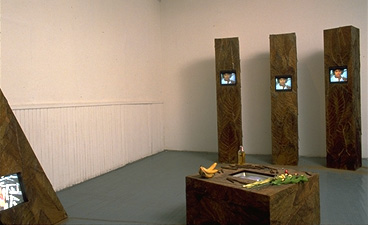 I
got in touch with Emilia, to tell her how much I'd discovered since we'd
first met. She somehow didn't share my enthusiasm, then shocked me by saying
that she didn't smoke cigars anymore and didn't want anything to do with Santeria.
Apparently the man who had introduced her to Santeria had been playing with
her head, leaving chicken feathers in front of her doorstep and blowing smoke
into her apartment. She said she was choking one night and was very scared.
In fact, a few of my friends had expressed concern that I had gotten involved
with the subject. I felt that I had my own spiritual strength to draw on and
since my motives were pure, there would be no place for attack. And the practitioners
had magic and divination at their disposal; they could have thrown coconut shells
and seen what I was all about.
I
got in touch with Emilia, to tell her how much I'd discovered since we'd
first met. She somehow didn't share my enthusiasm, then shocked me by saying
that she didn't smoke cigars anymore and didn't want anything to do with Santeria.
Apparently the man who had introduced her to Santeria had been playing with
her head, leaving chicken feathers in front of her doorstep and blowing smoke
into her apartment. She said she was choking one night and was very scared.
In fact, a few of my friends had expressed concern that I had gotten involved
with the subject. I felt that I had my own spiritual strength to draw on and
since my motives were pure, there would be no place for attack. And the practitioners
had magic and divination at their disposal; they could have thrown coconut shells
and seen what I was all about. Every
day I went down to the basement and worked with tobacco leaves and wood. I was
working on an installation at P.S. 1, which was to open on January 9th, my grandmother's
birthday. It consisted of six large objects, covered with tobacco leaves, with
videos inside, interviews with three women: Emilia, the artist, Basha, the priestess,
and Beatrice, the anthropologist. Through their stories I would present a completely
different viewpoint of the cigar and tobacco, the woman's point of view.
Every
day I went down to the basement and worked with tobacco leaves and wood. I was
working on an installation at P.S. 1, which was to open on January 9th, my grandmother's
birthday. It consisted of six large objects, covered with tobacco leaves, with
videos inside, interviews with three women: Emilia, the artist, Basha, the priestess,
and Beatrice, the anthropologist. Through their stories I would present a completely
different viewpoint of the cigar and tobacco, the woman's point of view. I
was walking barefoot on a dusty road somewhere in India, for days and days.
Exhausted, I arrived at an ancient temple at the steps of which was a monk.
I approached him, asking for directions; he didn't respond. A young girl came
up to me and said that he was in deep meditation and in another reality, he
couldn't hear me. I decided to go in and drink some water. As I passed the monk,
he opened his eyes and pointed at me: "She, she is the sacrifice." Terrified,
I started to run away, through the temple, into the garden. There was suddenly
a group of them behind me, chasing me like an animal. I ran desperately, approached
a small ruin of a house, ran through it, out the back door, again to a garden.
There I saw high stone steps, covered with moss. The stairway to heaven. I started
the long, long climb. There seemed to be no end. I was surrounded by beautiful
tropical greenery. I climbed and climbed, gasping for breath. When I reached
the top, on the last stair was the Woman. She was so ancient, transparent, dressed
in white. Her eyes were open, but she seemed to look right through me. I pleaded
with her: "They are right behind me, please help me, they want to sacrifice
me." She didn't respond, didn't move. I was desperate, how do I reach her, which
language does she speak. A lightning flash went off and I understood that not
words but only thought could save me.... I woke up in panic. Sacrifice, sacrifice.
The contact between us and God is enforced with sacrifice. This is how we receive
power. All ancient people have sacrificed first humans, then animals, finally
food. Now we reach a point of self-sacrifice. But 1, myself, must make that
decision; no one is allowed to put me to the stake.
I
was walking barefoot on a dusty road somewhere in India, for days and days.
Exhausted, I arrived at an ancient temple at the steps of which was a monk.
I approached him, asking for directions; he didn't respond. A young girl came
up to me and said that he was in deep meditation and in another reality, he
couldn't hear me. I decided to go in and drink some water. As I passed the monk,
he opened his eyes and pointed at me: "She, she is the sacrifice." Terrified,
I started to run away, through the temple, into the garden. There was suddenly
a group of them behind me, chasing me like an animal. I ran desperately, approached
a small ruin of a house, ran through it, out the back door, again to a garden.
There I saw high stone steps, covered with moss. The stairway to heaven. I started
the long, long climb. There seemed to be no end. I was surrounded by beautiful
tropical greenery. I climbed and climbed, gasping for breath. When I reached
the top, on the last stair was the Woman. She was so ancient, transparent, dressed
in white. Her eyes were open, but she seemed to look right through me. I pleaded
with her: "They are right behind me, please help me, they want to sacrifice
me." She didn't respond, didn't move. I was desperate, how do I reach her, which
language does she speak. A lightning flash went off and I understood that not
words but only thought could save me.... I woke up in panic. Sacrifice, sacrifice.
The contact between us and God is enforced with sacrifice. This is how we receive
power. All ancient people have sacrificed first humans, then animals, finally
food. Now we reach a point of self-sacrifice. But 1, myself, must make that
decision; no one is allowed to put me to the stake. In
the beginning there was a Woman. She created the World first in her Mind, then
through her electrical body. Her favorite place for meditation and creation
was on top of mountains that today we call the Himalayas. Her skin was transparent.
milkywhite, all the veins could be seen clearly. She had blue blood flowing
through. Her World was still. As She, the goddess Earth, created the seas, lakes,
rivers and oceans, the mist entered her pores and she had a terrible urge to
push. Through her third eye, millions of pearls were released, each of which
fumed into a different creature as it touched the Earth or the Waters.
In
the beginning there was a Woman. She created the World first in her Mind, then
through her electrical body. Her favorite place for meditation and creation
was on top of mountains that today we call the Himalayas. Her skin was transparent.
milkywhite, all the veins could be seen clearly. She had blue blood flowing
through. Her World was still. As She, the goddess Earth, created the seas, lakes,
rivers and oceans, the mist entered her pores and she had a terrible urge to
push. Through her third eye, millions of pearls were released, each of which
fumed into a different creature as it touched the Earth or the Waters. I
wonder how Freud would analyze that! Freud, the Father of psychoanalysis, who
needed cigars in order to work. He was fatally addicted, he who claimed that
addictions are substitutes for the "single great habit primal addiction"—masturbation.
He who wrote about women's "penis envy" was so obsessed with smoking cigars
that he developed a terrible cancer that caused him much suffering and pain.
He who wrote so much of the oral primitive needs failed at self-analysis and
epitomized the Western Man who has lost touch with Nature. It is true that Tobacco
causes cancer, but that is because the Ritual of worshipping Mother Nature has
been forgotten, and in our emptiness we seek endless gratification in overindulgence
of one sort or an' other. Freud and Jung had an exhaustive exchange about the
importance of smoking.
I
wonder how Freud would analyze that! Freud, the Father of psychoanalysis, who
needed cigars in order to work. He was fatally addicted, he who claimed that
addictions are substitutes for the "single great habit primal addiction"—masturbation.
He who wrote about women's "penis envy" was so obsessed with smoking cigars
that he developed a terrible cancer that caused him much suffering and pain.
He who wrote so much of the oral primitive needs failed at self-analysis and
epitomized the Western Man who has lost touch with Nature. It is true that Tobacco
causes cancer, but that is because the Ritual of worshipping Mother Nature has
been forgotten, and in our emptiness we seek endless gratification in overindulgence
of one sort or an' other. Freud and Jung had an exhaustive exchange about the
importance of smoking.